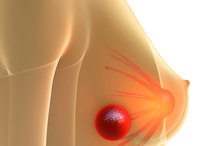What Are the Treatments for Fibroid Tumors on Breast?
A fibroid breast tumor, or fibroadenoma, is a benign breast growth that can occur in one or both breast 1. A fibroadenoma feels like a firm and rubbery lump that is usually painless to the touch and can be moved within the breast 1. The lumps can respond to circulating hormones and usually grow in size in response to pregnancy, and shrink during menopause. Once diagnosed, patients with fibroadenomas have a few treatment options.
Patience and Monitoring
Although not a surgical or drug treatment, the most common response following the diagnosis of a fibroadenoma is waiting to determine whether the lump will spontaneously regress. Since fibroadenoma tumors are non-invasive and benign, and have little capacity to turn into cancerous tumors, many patients with fibroadenomas do not undergo immediate treatment. A physician assess whether the fibroadenoma requires treatment based on the size of the growth and the symptoms experienced by the patient. MedlinePlus explains that if the fibroadenoma is left untreated, patients must undergo regular breast examinations, mammograms and ultrasounds to monitor the health of their breasts 1. If the tumor begins to grow or begins to cause significant pain, patients may seek fibroadenoma treatment.
- Although not a surgical or drug treatment, the most common response following the diagnosis of a fibroadenoma is waiting to determine whether the lump will spontaneously regress.
- MedlinePlus explains that if the fibroadenoma is left untreated, patients must undergo regular breast examinations, mammograms and ultrasounds to monitor the health of their breasts 1.
Surgery
What Are the Causes of Thickness in Breast Tissue?
Learn More
The most common treatment for a fibroadenoma is surgery to remove the lump. Since a fibroid tumor in the breast is non-cancerous, doctors performing the surgery can spare any unaffected breast tissue. The surgery for removing a fibroadenoma is a lumpectomy. During the procedure, the surgeon will make an incision in the breast tissue and surgically excise the fibrous lump. The doctor may also remove small biopsy specimens from healthy breast tissue to test for the presence of abnormal cells, then stich the wound to complete the procedure. After a lumpectomy, patients must take care to keep the surgical site clean to prevent infection. Normally, a simple lumpectomy is sufficient to remove the tumor, and can alleviate pain and discomfort for the patient.
- The most common treatment for a fibroadenoma is surgery to remove the lump.
- During the procedure, the surgeon will make an incision in the breast tissue and surgically excise the fibrous lump.
Cryoablation
Another treatment option for patients with fibroadenoma is cryoablation, a procedure in which the doctor freezes the fibroid lump. During the procedure, the doctor will make a small incision in the breast tissue and insert an ultrasound probe, allowing the doctor to image inside the breast. The fibroid lump is then frozen, killing the tumor cells. Once the tissue is frozen, the doctor removes the probe and closes the wound. The Center for Advanced Breast Care explains that once the tissue is frozen, it gradually gets broken down by the body over a period of six to 12 months 3. Since cryoablation is a less invasive procedure than surgery, it can be an attractive treatment option for patients with smaller or less severe fibroid tumors of the breast.
- Another treatment option for patients with fibroadenoma is cryoablation, a procedure in which the doctor freezes the fibroid lump.
- During the procedure, the doctor will make a small incision in the breast tissue and insert an ultrasound probe, allowing the doctor to image inside the breast.
Related Articles
References
- MedlinePlus: Fibroadenoma - breast
- Ajmal M, Van Fossen K. Breast Fibroadenoma. Treasure Island, FL: StatPearls Publishing. Updated November 11, 2019.
- Papathemelis T, Heim S, Lux MP, Erhardt I, Scharl A, Scharl S. Minimally invasive breast fibroadenoma excision using an ultrasound-guided vacuum-assisted biopsy device. Geburtshilfe Frauenheilkd. 2017;77(2):176-181. doi:10.1055/s-0043-100387
- Li P, Xiao-Yin T, Cui D, et al. Evaluation of the safety and efficacy of percutaneous radiofrequency ablation for treating multiple breast fibroadenoma. J Cancer Res Ther. 2016;12(Supplement):C138-C142. doi:10.4103/jcrt.JCRT_966_16
- Peek MCL, Ahmed M, Scudder J, et al. High-intensity focused ultrasound in the treatment of breast fibroadenomata (HIFU-F trial). Int J Hyperthermia. 2018;34(7):1002-1009. doi:10.1080/02656736.2017.1373865
- Hartmann LC, Sellers TA, Frost MH, et al. Benign breast disease and the risk of breast cancer. N Engl J Med. 2005;353(3):229-237. doi:10.1056/NEJMoa044383
- American Cancer Society. Fibroadenomas. 2017.
- Cavallo Marincola B, Pediconi F, Anzidei M, et al. High-intensity focused ultrasound in breast pathology: non-invasive treatment of benign and malignant lesions. Expert Rev Med Devices. 2015;12(2):191-199. doi:10.1586/17434440.2015.986096
- Peek M, Douek M. Ablative techniques for the treatment of benign and malignant breast tumours. Journal of Therapeutic Ultrasound. 2017;5:18. doi:10.1186/s40349-017-0097-8
Writer Bio
Sylvie Tremblay holds a Master of Science in molecular and cellular biology and has years of experience as a cancer researcher and neuroscientist. Based in Ontario, Canada, Tremblay is an experienced journalist and blogger specializing in nutrition, fitness, lifestyle, health and biotechnology, as well as real estate, agriculture and clean tech.









